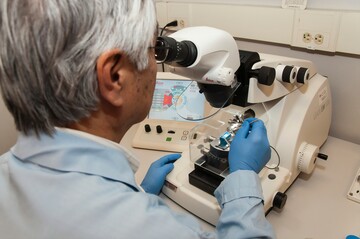What is an experiment?

Investigating microscopic structures and organisms.

Investigating microscopic structures and organisms.
An experiment is a test of an idea or a method. It is a way to find out how something works or what will happen if you do something. Experiments are often done in science, but they can also be done in other subjects, like math, engineering, and cooking.
There are many different types of experiments. Some experiments are simple, like testing whether a ball will bounce higher if it is dropped from a higher height. Other experiments are more complex, like testing how different types of soil affect the growth of plants.
No matter what type of experiment you are doing, there are some basic steps that you need to follow. First, you need to come up with a question that you want to answer. Then, you need to make a hypothesis, which is a guess about what you think the answer to your question will be. Next, you need to design an experiment that will test your hypothesis. This means that you need to decide what materials you will need, what steps you will take, and how you will measure the results.
Once you have designed your experiment, you need to carry it out. This is the most important step! You need to be careful to follow your plan exactly so that your results are accurate.
After you have carried out your experiment, you need to collect the data and analyze it. This means that you need to look at your results and see if they support your hypothesis. If they do, then your hypothesis was correct! If they don't, then you need to go back and think about why your results were different from what you expected.
Experiments are a great way to learn about the world around you. They can help you to understand how things work and to make predictions about what will happen in the future. If you are interested in science or in learning more about how things work, then I encourage you to try doing some experiments yourself!
Here are some examples of experiments that you can do at home:
- Test whether different types of paper towels absorb more water.
- Test whether different types of seeds grow faster.
- Test whether different types of music make plants grow faster.
- Test whether different types of foods make you feel full faster.
These are just a few examples, there are many other experiments that you can do. The most important thing is to be creative and to have fun!
How can experimental design be used to make new discoveries?
Experimental design can be used to make new discoveries by experimenting with different ideas or methods. For example, let's say you want to find out which type of fertilizer helps plants grow the tallest. You might design an experiment where you plant seeds in different pots, give each pot a different type of fertilizer, and then measure how tall the plants grow. By carefully designing your experiment and collecting data, you can make new discoveries about which fertilizer works best.
What is a controlled experiment?
In a controlled experiment, you keep everything the same except for one thing that you want to test. This helps you see if the thing you are testing has an effect. For instance, let's say you want to find out if music affects how fast plants grow. In a controlled experiment, you would keep all the conditions the same, like using the same type of soil and giving the plants the same amount of water and sunlight. The only thing you would change is the type of music the plants are exposed to. This way, you can see if the music has any impact on the growth of the plants.

Investigating microscopic structures and organisms.